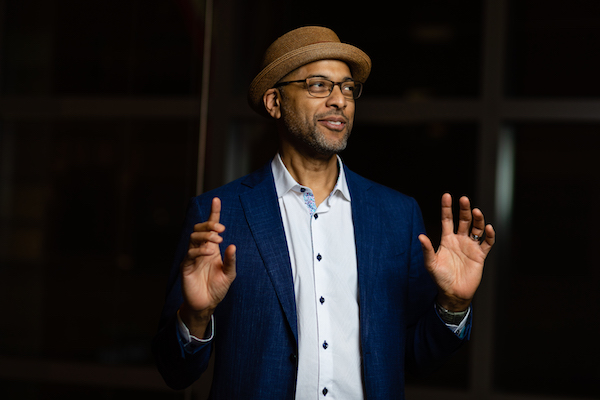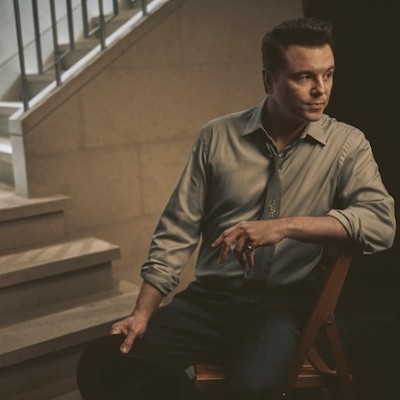Dec 9, 2025 12:28 PM
In Memoriam: Gordon Goodwin, 1954–2025
Gordon Goodwin, an award-winning saxophonist, pianist, bandleader, composer and arranger, died Dec. 8 in Los Angeles.…

Andy Milne is fascinated by the connections among medical science, music and healing.
(Photo: Anna Yatskevich)“The music for the trio is quite different from all of the other stuff that Andy’s done out there,” Penn said. “It’s introspective and calm, but at the same time, there’s an intense burning going on.”
Milne included only one tune he hadn’t composed himself: Tyner’s “Passion Dance,” from the groundbreaking pianist’s first album for Blue Note, The Real McCoy. Milne’s version, though faithful to the original, has its own surprising harmonic colors and unremitting forcefulness—as an homage, it took on greater meaning with the news of Tyner’s death on March 6.
In an email, Milne responded to the loss of his idol: “One of my first jazz recordings was McCoy’s Inner Voices,” he wrote. “It was perhaps an unusual point of entry because it featured a large vocal chorus. I think that this, in some way, helped shaped my openness towards collaborating across genres and living outside of traditional ensemble structures. I also identified with how [Tyner] created a musical response to the unprecedented chair that he occupied in Trane’s quartet at such a young age. This, for sure, inspired me, as I searched for ways of navigating my role when joining Steve Coleman’s [M-BASE Collective] in 1991.”
As Milne’s email suggests, there are parallels between the two pianists’ careers. As young musicians, both learned to swim in the deep end of a powerful group led by a master innovator, and both drew on that experience later in forming their own innovative ensembles. Tyner, too, went on to explore the trio format after leaving John Coltrane’s quartet in 1965.
“There are ways of thinking of the piano inside of larger ensembles,” Milne explained, pointing out that the piano line disappears in some configurations in a way that it doesn’t with trios. “I’ve had to find my survival techniques to cope in all those years of touring with larger groups. It never felt like the piano really sang, because in order to make it work, you have to do things that just really suck the beauty out of the instrument. Then you can’t appreciate the subtle textures.”
Alessi readily attests to Milne’s adaptability across a variety of musical contexts. The two first met at Banff Centre’s jazz workshop in Alberta, Canada, in the early 1990s and have been frequent collaborators since, from the M-BASE Collective 25 years ago (when Alessi joined) through to Imaginary Friends (ECM), the trumpeter’s elegant 2019 album, which he recorded with Milne, Ravi Coltrane (saxophone), Drew Gress (bass) and Mark Ferber (drums).
“Conceptually, Andy’s music has really evolved dramatically over the years,” Alessi said. “Partly because of the influence of playing in different situations with different musicians, but also because of the choice of musicians that he plays with. ... That kind of mix makes the music very compelling, when you have these disparate elements all working together.”
Disparate, yes—but equal. All members of the trio are quick to emphasize the trilateral nature of the group’s aesthetic; Penn and Hébert attribute this balance to Milne’s insight into what makes a trio work.
“A lot of leaders want to solo all the time, and it’s all about them,” Penn said. “In this trio, Andy really gives an equal amount of space to the two of us. He wants to make sure that it’s considered a trio—with three equal parts.”
Hébert echoed Penn’s sentiment, speaking by phone from his home in Kalamazoo, Michigan, where he and his family had relocated just before New York City locked down. “There’s a lot more interplay and freedom in a trio setting, and within that, way more responsibility, because we’re under the microscope. [In this setting], Andy has a way of delegating responsibilities that also allows us to be free. He wants us to explore who we are and what we can bring to his music. At the same time, he’s holding us together, so it doesn’t get too out of control. It’s a fine line. But that’s the beauty of a trio.”
Two days after the interview in Manhattan, Milne flew to Ann Arbor, Michigan, where he now teaches full-time in the Department of Jazz and Contemporary Improvisation at the University of Michigan. He’d received the job offer in 2018, when he was undergoing all those grueling cancer treatments, and started there that fall.
What he found at his new job surprised him. “I quickly discovered that I was in a huge research institution, doing wonderful things with a fabulous performing arts school,” he said. “Opportunities to collaborate across disciplines as a full-time faculty member became very tangible. So, within a semester, all of a sudden I’m working on things that are important to me—like a platform to help people deal with chronic pain, with someone from medicine and someone from design.”
As an educator, Milne can use these cross-disciplinary collaborations as another way to teach his students something about music that reaches beyond the fundamentals of time, pitch and voice leadings. Part of his work with students, he explained, is to demystify the uniqueness of their own creative struggle by putting it in the context of musicians who have come before them.
With the spread of the coronavirus throughout the United States, the University of Michigan has shuttered its classrooms and switched to remote learning, as has Western Michigan University, where Hébert teaches, and Rutgers University, where Penn is finishing a master’s degree. Milne and his two bandmates aren’t sure if their trio gigs—or any of their spring and summer gigs—will happen as scheduled.
Even in this challenge, though, Milne finds opportunity. He’s been using video conferencing platforms to work with his students from a distance, and through this technology he has moderated weekly guest-artist sessions, bringing expert musicians to speak—which might not otherwise have been possible.
Learning directly from masters, as Milne did, could help students develop what he calls an “aesthetic constitution.” To elucidate, he again used a building metaphor: A plumber comes to your house to fix a broken pipe and goes right to the one tool among many needed to remedy the problem. Such mastery is about technical expertise, coupled with wisdom. That’s what he’s there to teach, he said.
“I see artistry in so many different domains,” he continued. “The workshop, the kitchen, the painter’s studio, the dance studio. In a surgeon who can carve you open and know that they can spare all those nerves, get the bad cells, and have you out of there in four hours. And you’ll be OK. That’s artistry. I identify with that.” DB
This story originally was published in the June 2020 issue of DownBeat.

Goodwin was one of the most acclaimed, successful and influential jazz musicians of his generation.
Dec 9, 2025 12:28 PM
Gordon Goodwin, an award-winning saxophonist, pianist, bandleader, composer and arranger, died Dec. 8 in Los Angeles.…

Flea has returned to his first instrument — the trumpet — and assembled a dream band of jazz musicians to record a new album.
Dec 2, 2025 2:01 AM
After a nearly five-decade career as one of his generation’s defining rock bassists, Flea has returned to his first…

“It’s a pleasure and an honor to interpret the music of Oscar Peterson in his native city,” said Jim Doxas in regard to celebrating the Canadian legend. “He traveled the world, but never forgot Montreal.”
Nov 18, 2025 12:16 PM
In the pantheon of jazz luminaries, few shine as brightly, or swing as hard, as Oscar Peterson. A century ago, a…

Dec 11, 2025 11:00 AM
DownBeat presents a complete list of the 4-, 4½- and 5-star albums from 2025 in one convenient package. It’s a great…

Seth MacFarlane takes a turn from his television and film career to sing arrangements made for Frank Sinatra, but never recorded.
Nov 18, 2025 12:04 PM
“I’m not gonna lie to you — I don’t know why I thought this was about The Naked Gun, but I’m happy it’s…